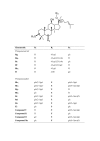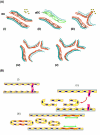Pharmacogenomics and the Yin/Yang actions of ginseng: anti-tumor, angiomodulating and steroid-like activities of ginsenosides
- PMID: 17502003
- PMCID: PMC1876803
- DOI: 10.1186/1749-8546-2-6
Pharmacogenomics and the Yin/Yang actions of ginseng: anti-tumor, angiomodulating and steroid-like activities of ginsenosides
Abstract
In Chinese medicine, ginseng (Panax ginseng C.A. Meyer) has long been used as a general tonic or an adaptogen to promote longevity and enhance bodily functions. It has also been claimed to be effective in combating stress, fatigue, oxidants, cancer and diabetes mellitus. Most of the pharmacological actions of ginseng are attributed to one type of its constituents, namely the ginsenosides. In this review, we focus on the recent advances in the study of ginsenosides on angiogenesis which is related to many pathological conditions including tumor progression and cardiovascular dysfunctions. Angiogenesis in the human body is regulated by two sets of counteracting factors, angiogenic stimulators and inhibitors. The 'Yin and Yang' action of ginseng on angiomodulation was paralleled by the experimental data showing angiogenesis was indeed related to the compositional ratio between ginsenosides Rg1 and Rb1. Rg1 was later found to stimulate angiogenesis through augmenting the production of nitric oxide (NO) and vascular endothelial growth factor (VEGF). Mechanistic studies revealed that such responses were mediated through the PI3K-->Akt pathway. By means of DNA microarray, a group of genes related to cell adhesion, migration and cytoskeleton were found to be up-regulated in endothelial cells. These gene products may interact in a hierarchical cascade pattern to modulate cell architectural dynamics which is concomitant to the observed phenomena in angiogenesis. By contrast, the anti-tumor and anti-angiogenic effects of ginsenosides (e.g. Rg3 and Rh2) have been demonstrated in various models of tumor and endothelial cells, indicating that ginsenosides with opposing activities are present in ginseng. Ginsenosides and Panax ginseng extracts have been shown to exert protective effects on vascular dysfunctions, such as hypertension, atherosclerotic disorders and ischemic injury. Recent work has demonstrates the target molecules of ginsenosides to be a group of nuclear steroid hormone receptors. These lines of evidence support that the interaction between ginsenosides and various nuclear steroid hormone receptors may explain the diverse pharmacological activities of ginseng. These findings may also lead to development of more efficacious ginseng-derived therapeutics for angiogenesis-related diseases.
Figures







Similar articles
-
Modulating angiogenesis: the yin and the yang in ginseng.Circulation. 2004 Sep 7;110(10):1219-25. doi: 10.1161/01.CIR.0000140676.88412.CF. Epub 2004 Aug 30. Circulation. 2004. PMID: 15337705
-
Structural-Activity Relationship of Ginsenosides from Steamed Ginseng in the Treatment of Erectile Dysfunction.Am J Chin Med. 2018;46(1):137-155. doi: 10.1142/S0192415X18500088. Epub 2018 Jan 3. Am J Chin Med. 2018. PMID: 29298510
-
Generation of ginsenosides Rg3 and Rh2 from North American ginseng.Phytochemistry. 2004 Feb;65(3):337-44. doi: 10.1016/j.phytochem.2003.11.020. Phytochemistry. 2004. PMID: 14751305
-
Role of ginsenosides, the main active components of Panax ginseng, in inflammatory responses and diseases.J Ginseng Res. 2017 Oct;41(4):435-443. doi: 10.1016/j.jgr.2016.08.004. Epub 2016 Aug 18. J Ginseng Res. 2017. PMID: 29021688 Free PMC article. Review.
-
Pro-Resolving Effect of Ginsenosides as an Anti-Inflammatory Mechanism of Panax ginseng.Biomolecules. 2020 Mar 13;10(3):444. doi: 10.3390/biom10030444. Biomolecules. 2020. PMID: 32183094 Free PMC article. Review.
Cited by
-
Comprehensive Investigation on Ginsenosides in Different Parts of a Garden-Cultivated Ginseng Root and Rhizome.Molecules. 2021 Mar 18;26(6):1696. doi: 10.3390/molecules26061696. Molecules. 2021. PMID: 33803599 Free PMC article.
-
The Gintonin-Enriched Fraction of Ginseng Regulates Lipid Metabolism and Browning via the cAMP-Protein Kinase a Signaling Pathway in Mice White Adipocytes.Biomolecules. 2020 Jul 15;10(7):1048. doi: 10.3390/biom10071048. Biomolecules. 2020. PMID: 32679738 Free PMC article.
-
Induction of apoptosis by the ginsenoside Rh2 by internalization of lipid rafts and caveolae and inactivation of Akt.Br J Pharmacol. 2010 Jul;160(5):1212-23. doi: 10.1111/j.1476-5381.2010.00768.x. Br J Pharmacol. 2010. PMID: 20590613 Free PMC article.
-
High frequency somatic embryogenesis and plant regeneration of interspecific ginseng hybrid between Panax ginseng and Panax quinquefolius.J Ginseng Res. 2019 Jan;43(1):38-48. doi: 10.1016/j.jgr.2017.08.002. Epub 2017 Aug 11. J Ginseng Res. 2019. PMID: 30662292 Free PMC article.
-
Engineered three-dimensional scaffolds for enhanced bone regeneration in osteonecrosis.Bioact Mater. 2020 Apr 17;5(3):584-601. doi: 10.1016/j.bioactmat.2020.04.008. eCollection 2020 Sep. Bioact Mater. 2020. PMID: 32405574 Free PMC article.
References
-
- Hu SY. A contribution of our knowledge of ginseng. Am J Chin Med. 1977;5:1–23. - PubMed
-
- Tao HC. Sheng-Nung-Pen-Tsao-Ching. Taipei, Taiwan: Chung-Hwa; 1955.
-
- Liu CX. Introduction on research of ginseng. Information of Traditional Chinese Medicine. 1975;2:9–11.
-
- Liu CX. Pharmacology and clinic of active principles of ginseng. Chinese Traditional Herbs and Drugs. 1975;7:57.
-
- Liu CX, Xiao PG. Recent advances on ginseng research in China. J Ethnopharmacol. 1992;36:27–38. - PubMed
LinkOut - more resources
Full Text Sources
Miscellaneous

